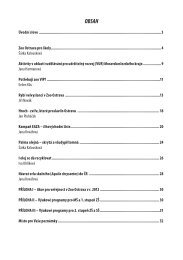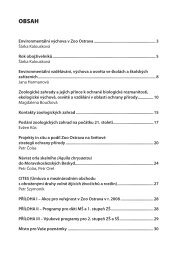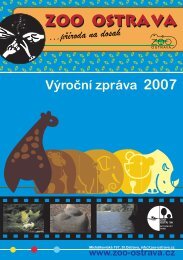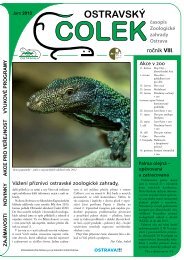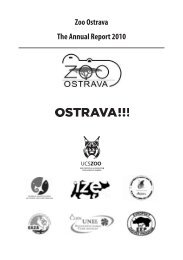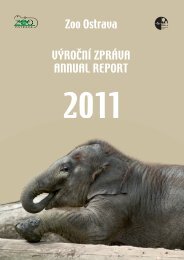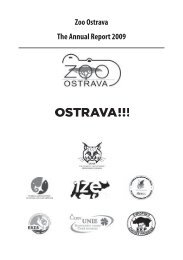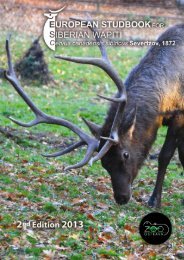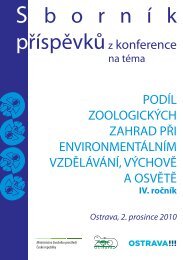Most of the animals listed below are temporarily placed out of scenes, waiting for the new exhibits to openin 2010. In <strong>2009</strong>, for example, the zoo imported the Asian small-clawed otter (Aonyx cinerea) for the Chitwanexhibit - so far the only mustelid within the stock, a Red List species managed as vulnerable. The Chitwancomplex, where the zoo wishes to present animals of the well-known Nepalese national park, and whichis to provide some already established stock members like bears and langurs with better conditions, willinclude two aquaria. They will be the first freshwater exhibit tanks at <strong>Ostrava</strong> <strong>Zoo</strong>, with the freshwater garfish(Xenentodon cancila) being one of very intriguing species. Other fish taxa are to range in the aquaria of theexhibit called Papua, where visitors can admire magnificent members of New Guinea fish life, for examplethe northern saratoga (Scleropages jardinii) and Atlantic mudskipper (Periophthalmus barbarus), but alsoreptiles - the blue-spotted monitor (Varanus macraei) - the first monitor lizard at <strong>Ostrava</strong> <strong>Zoo</strong>, as well as theSiebenrock's or northern long-necked turtle (Chelodina siebenrocki) and New Guinea snapping turtle (Elseyanovaeguineae), the zoo's first snake-necked turtle species. In the aviary adjoining the Papua display, the bluewingedkookaburra (Dacelo leachii) is to be a new species. Ready to settle in the future nocturnal exhibit isthe first representative of the hyrax order - the southern tree hyrax (Dendrohyrax arboreus), husbandry ofthis species kept behind the scenes being now one of the tasks of animal managers. Other creatures heldcurrently out of scenes include wonders, as is the critically endangered Siberian crane (Grus leucogeranus),the northern bald ibis or waldrapp (Geronticus eremita), endangered Baer's pochard (Aythya baeri) or whiteneck-laced partridge (Arborophila gingica), a vulnerable species in the wild. These species are coming soonon display. On the other hand, some creatures were out to please the visitors, whether laymen or experts,already in <strong>2009</strong>, be it the Dalmatian pelican (Pelecanus crispus) on the pond, the Chinese merganser (Mergussquamatus) in the Chinese fauna exhibit, the Madagascar or common fody (Foudia madagascariensis) in theMadagascar exhibit, the silver shark (Balantiocheilos melanopterus) inside the Elephant Jungle or many others.In the Little Amazonia exhibit, there is another number of new species to admire, among them being thefirst <strong>Ostrava</strong>'s member of primates called clawed monkeys, the cotton-top tamarin (Saguinus oedipus). Heldvery frequently in zoos elsewhere, this primate is however a critically endangered species in the wild.Selecting species that could be placed on the top of the list as seen by an expert in zoology would be ahard job - all of them are the best. So to conclude, let me try to summarise the results of the joint efforts ofthe zoo team: at the end of 2008, <strong>Ostrava</strong> held 305 animal species and 1,535 individuals. A year later, the listincluded as much as 2,919 animals of 354 species, meaning the number of species has increased by 16%, whilethe number of individuals has almost doubled and it is my strong belief that there are even more new andinteresting animals coming in 2010 to which we all can look with expectations.42
Keeping a new primate species at <strong>Ostrava</strong> <strong>Zoo</strong>Karin TančibokováSince the mid-year 2008, building alterations in the entrance part of the parrot house commenced toprovide for a new exhibit named “Little Amazonia”. The rebuilding process cost the zoo 1.9 million CZK, with1.5 million extended by OKD Foundation and the remainder co-funded from the allocation of the StatutoryCity of <strong>Ostrava</strong>. Formally opened on 18 April, this exhibit became home to new dwellers, including primatesthat were never held in <strong>Ostrava</strong> before.The cotton-top tamarin (Saguinus oedipus), a critically endangered member of the callitrichid family,primates that feature nails converted into little claws on each of the digits except the big toes. Their ratherlong body, limbs and tail as well as their claws make callitrichids very well adapted for climbing thick treetrunks. The cotton-top tamarin measures 210-250 cm and its weight ranges from 400 to 500 g. The back isbrown with light marble pattern, while the underparts including limbs are white. They feature heavy-lookingwhite hairs on their nape, so are sometimes dubbed Liszt monkeys as they are said to resemble the famouscomposer. Pregnancy takes 140 days; the female will mostly bear twins or even triplets, but the latter is rare.Tamarins live in small family clans, with both parents caring for the infants. The young ones are carried by themale and older siblings on their back and delivered to the female only for feeding. This tamarin can live forup to 15 years. The cotton-top tamarin is a diurnal creature that will spend most of its time in trees, searchingfor food almost all day long, feeding on fruits, young leaves and buds, but also insects and nectar. Whenthreatened, the tamarin will stand up on its hind limbs, erecting the prolonged hairs on the nape. Whenvocalising, cotton-top tamarin's voice sounds like bird singing.At the moment, there are more cotton-top tamarins in zoos and private holders than in the wild, whichprobably is due to the use of this primate in pharmacy throughout Europe, being the reason for their imports.The species' range is limited only to northern Columbia, a region where biodiversity is relatively high, butconservation rather poor, with converting forests into the farming land and development of water powerplants posing the main threats not only to tamarins.For the new exhibit, a family group was imported to the zoo from Dresden, which involved a breeding pairand four juveniles. In the latter half of May, the female Isabel gave birth to twins. The family was really a goodexample of a breeding group. In September <strong>2009</strong>, the young but already sexually mature males tried to chasethe dominant male Leopold away from the group, with Isabel eventually joining these efforts. Three youngmales had to be separated from the group and placed behind the scenes. Leopold was separated as well dueto its injuries, with subsequent treatment lasting one month; then this animal could be reunited with thegroup.Attractiveness is added to the Little Amazonia through several components, like the vivarium containingtiny frog species - the three-striped poison frog (Ameerega trivittata) and the golden poison frog (Phyllobatesterribilis), the naturalistic display showing peculiar invertebrates - death's head cockroaches (Blaberuscraniifer) and the white-banded tarantula (Acanthoscurria geniculata), and the artificial waterfall witha water tank for freshwater creatures, with the ocellate river stingray (Potamotrygon motoro) - the firstmember of cartilaginous fishes at <strong>Ostrava</strong> <strong>Zoo</strong>, black band myleus or disk tetra (Myleus schomburgkii) andbanded leporinus (Leporinus fasciatus) being certainly the worth-mentioning species.43
- Page 2 and 3:
Provozovatel zoo: Zoologická zahra
- Page 5 and 6:
ObsahÚvodní slovo ředitelePetr
- Page 7 and 8:
Vážení příznivci Zoo Ostrava,d
- Page 9 and 10:
Stavy chovaných zvířatChov zví
- Page 12 and 13:
pečovaly o mláďata z roku předc
- Page 15 and 16:
2) z účelově vázaného přísp
- Page 17 and 18:
Rok 2009 byl pro naši organizaci v
- Page 19 and 20:
Výnosy v roce 2009v tis.Kč% změn
- Page 21 and 22:
Osobní náklady tj. vlastní mzdy,
- Page 23 and 24:
Výstavba, projektová činnost a
- Page 25 and 26:
Z dalších změn v areálu zoo sto
- Page 27 and 28:
• byla dokončena projektová př
- Page 29 and 30:
Vzdělávací a propagační činno
- Page 31 and 32:
• 25.7. Když si zvířata hrají
- Page 33 and 34:
Činnost dendrologického oddělen
- Page 35 and 36:
Pozorování a sběr údajů o zví
- Page 37 and 38:
Rok šelem v Zoo OstravaMonika Ondr
- Page 39 and 40:
Historický nárůst počtu chovan
- Page 41 and 42:
Chov nového druhu primáta v Zoo O
- Page 43 and 44:
akovinným bujením, které zapří
- Page 45 and 46:
Odchov supa hnědého v Zoo Ostrava
- Page 47 and 48:
Repatriace supa hnědého a orlosup
- Page 49 and 50:
ještě před vylétnutím a jejich
- Page 51 and 52:
Odchov ohrožených druhů papoušk
- Page 53 and 54:
tuto budku přijali. Opět si vytvo
- Page 55 and 56:
pobývali většinou venku, mládě
- Page 57 and 58:
Novinky u slonůPavel ZvolánekRok
- Page 59 and 60:
při průchodu porodními cestami,
- Page 61 and 62:
Róze se poslední mládě narodilo
- Page 63 and 64:
Návrat orla skalního (Aquila chry
- Page 65 and 66:
Seznam zaměstnanců Zoo Ostrava (k
- Page 67 and 68:
Jméno Funkce Počet let v org.62 P
- Page 69 and 70:
Druh (poddruh)Species (subspecies)S
- Page 71 and 72:
Druh (poddruh)Species (subspecies)S
- Page 73 and 74:
Druh (poddruh)Species (subspecies)S
- Page 75 and 76:
Druh (poddruh)Species (subspecies)S
- Page 77 and 78:
Druh (poddruh)Species (subspecies)S
- Page 79 and 80:
Druh (poddruh)Species (subspecies)S
- Page 81 and 82:
Druh (poddruh)Species (subspecies)S
- Page 83 and 84:
Druh (poddruh)Species (subspecies)S
- Page 85 and 86:
Druh (poddruh)Species (subspecies)S
- Page 87 and 88:
Druh (poddruh)Species (subspecies)S
- Page 89 and 90:
Druh (poddruh)Species (subspecies)S
- Page 91 and 92:
Druh (poddruh)Species (subspecies)M
- Page 93 and 94:
FormaFormazajícovci (Lagomorpha)St
- Page 95 and 96:
▲ Nejvzácnější přírůstek r
- Page 97 and 98:
▲ Úprava vnitřních prostor v p
- Page 99 and 100: ▲ Odběr spermatu u samce slona i
- Page 101 and 102: ◀ Nový druh v Zoo Ostrava - peli
- Page 103 and 104: ▶ Pohlednice u voliéry supů hn
- Page 105 and 106: ◀ Google v zoo při sběru datpro
- Page 108 and 109: Zoological Garden OstravaAddress: Z
- Page 111 and 112: ContentsDirector´s introductory wo
- Page 113 and 114: Dear friends,Ostrava Zoo is coming
- Page 115 and 116: Animal numbersAnimal collection in
- Page 117 and 118: of which a member of the very rare
- Page 119 and 120: success refers to the offspring pro
- Page 121 and 122: The founder’s non-capital funding
- Page 123 and 124: 3) CZK 737 thousand allocated to re
- Page 125 and 126: To co-fund 46.4% from the operating
- Page 127 and 128: As regards cost items in 2009, only
- Page 129 and 130: namely tiger enclosures, hoofed mam
- Page 131 and 132: Design, development and maintenance
- Page 133 and 134: This operation was supported by the
- Page 135 and 136: • Development of the building app
- Page 137 and 138: Ostrava Zoo - the zoo office and ma
- Page 139 and 140: Again, the event was co-funded by t
- Page 141 and 142: and involved models of a turtle she
- Page 143 and 144: Activities of the Horticulture Depa
- Page 145 and 146: and it was carried out by the scien
- Page 147 and 148: A year of carnivores at Ostrava Zoo
- Page 149: Historical increase in the number o
- Page 153 and 154: for the lemurs, where the family of
- Page 155 and 156: Month 8 Beira's climbing the ropes
- Page 157 and 158: as the birds changed over on 28 Apr
- Page 159 and 160: • Birds of prey are rather slow i
- Page 161 and 162: Monitoring nests of endangered bird
- Page 163 and 164: The yellow cardinal at Ostrava ZooY
- Page 165 and 166: a bowl with fresh water multiple ti
- Page 167 and 168: it was found that one egg was impre
- Page 169 and 170: eginnings when the young are fed by
- Page 171 and 172: The way the bull was handled within
- Page 173 and 174: Keeping the common hippopotamus (Hi
- Page 175 and 176: Studbook # /nameSexDate ofbirthDam/
- Page 177 and 178: General summaryThanks to the projec
- Page 179 and 180: NamePositionNumber of yearsin the o



